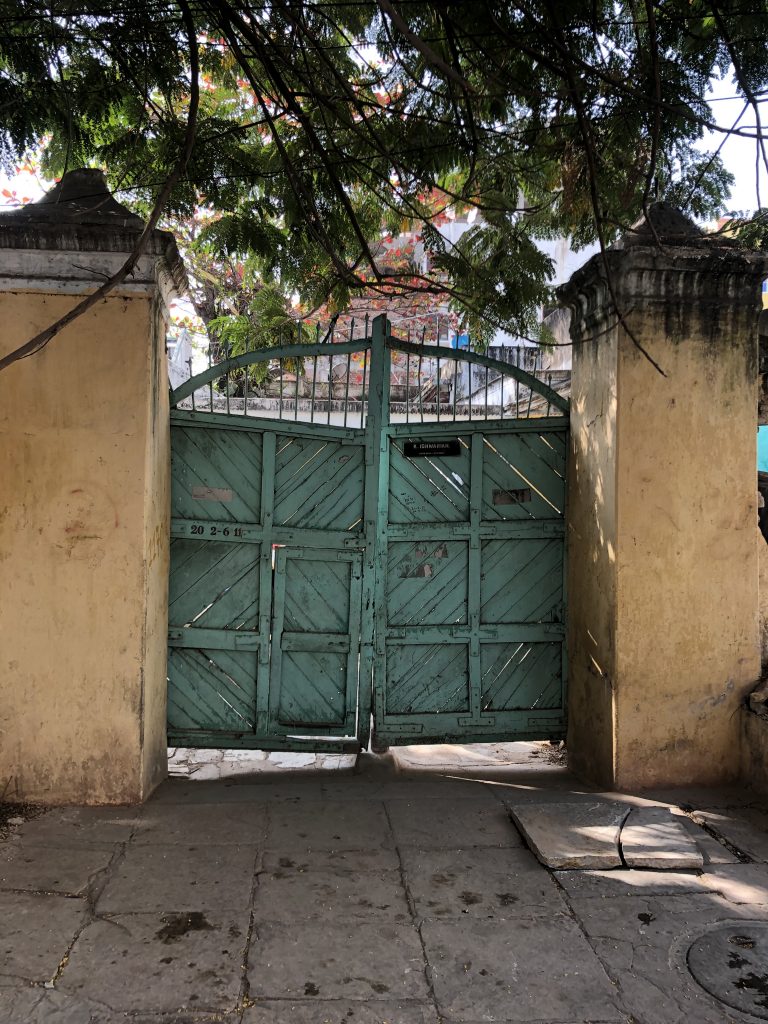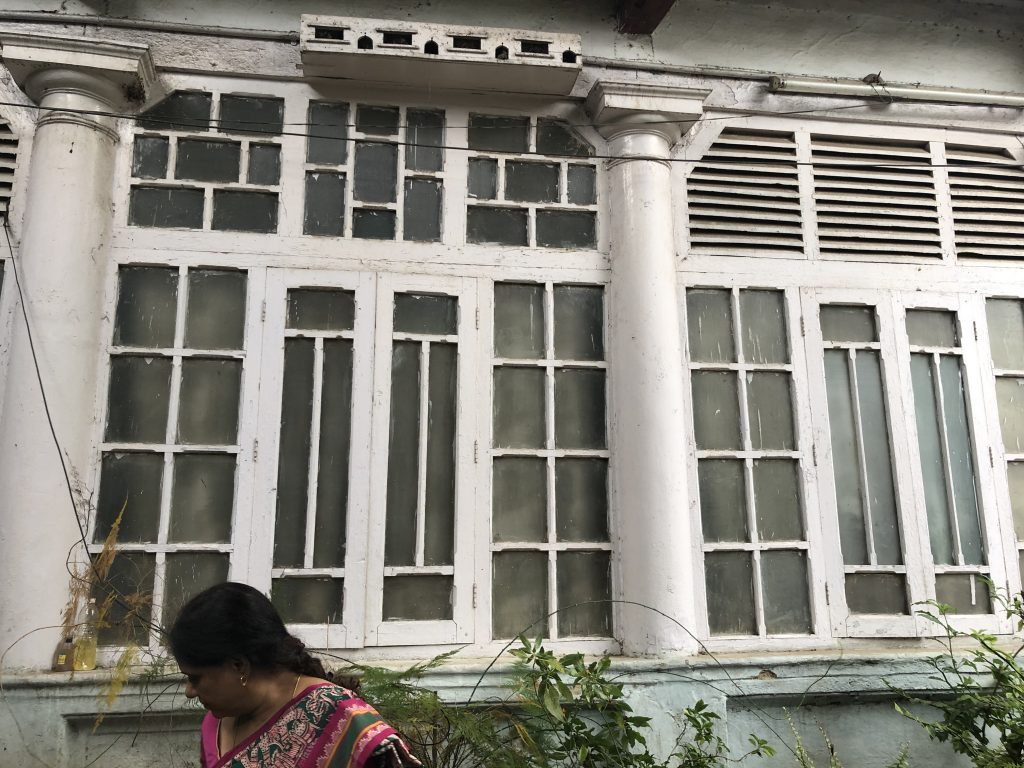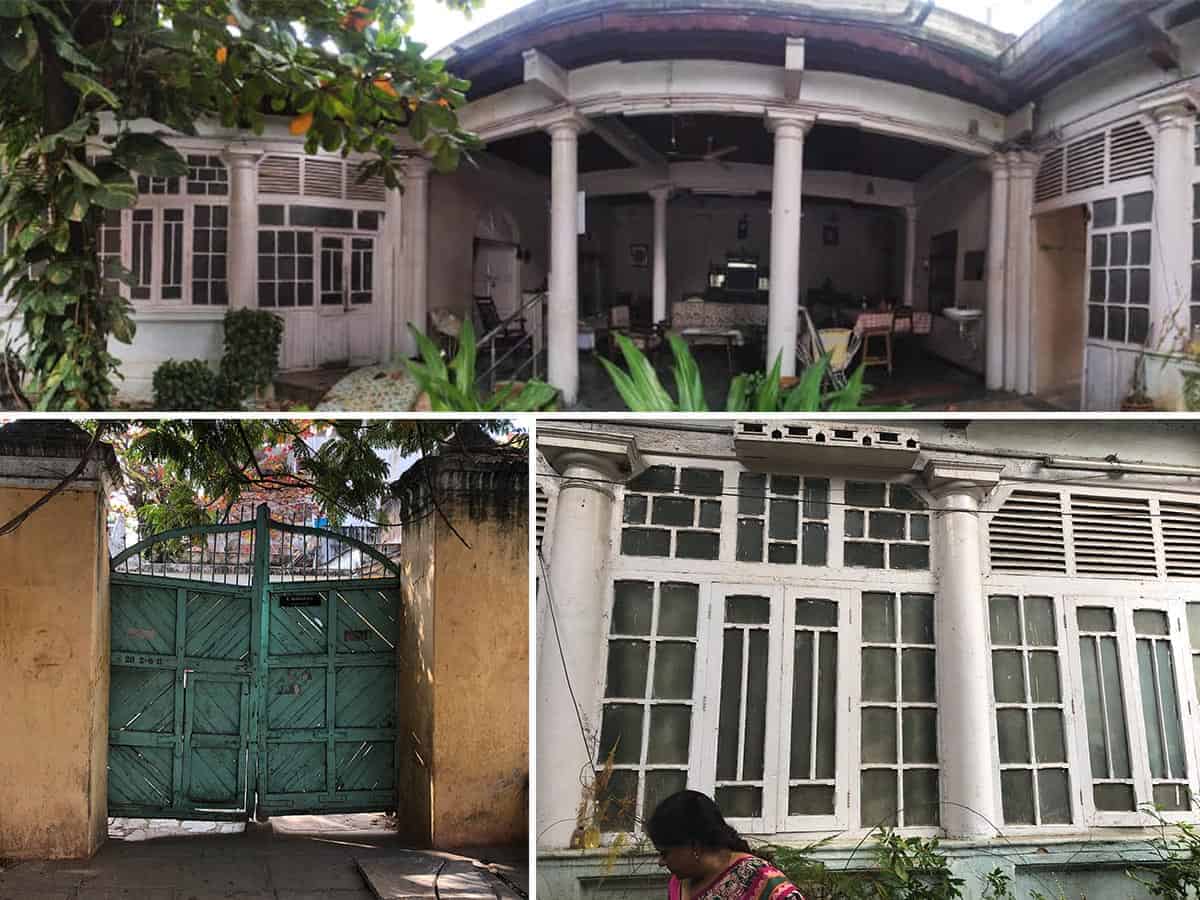
As I mourn the merciless pulling down of my spacious ancestral mini-devdi in historic Hussaini Alam by the Greater Hyderabad Municipal Corporation (GHMC) as part of their haphazardly planned needless road widening programme, I am overwhelmed, fond memories of my childhood come rushing back.
Preposterous it may sound for outsiders, but our modest mansion has been a local landmark virtually sandwiched between the Qutub Shahi era Hussaini Alam Ashoorkhana and the residence of Hazrat Abdullah Shah Saheb. It had a distinct huge wooden garishly painted green gate standing between two tall masonry columns. The compound wall on either side was always awash in yellow ‘Peeli Matti”. In the days gone by when we wanted to return home from Abids, all we used to tell the rickshaw puller was to take us to “Hussaini Alam Baragalli mode, Abdullah Shah Saab ke makaan ke bazu hara pathak”. Within half an hour you are there in front of ourgreen gate, now a memorable tag for our family and house!

Blessed we were to be the nextdoor neighbour of a revered moulvi, Hazrat Abdullah Shah Saheb, one of the eminent scholars of Islam who earned the title of “Muhaddis-e-Deccan”. Shah Saheb wrote extensively on Islamic jurisprudence and compiled his best-known five-volume work “Zujajat al-Masabih”. Famous for his scholarly exegesis of Qur’an and expounder of other Islamic religious texts, he was recognised as one of the most celebrated Sufis produced by India in the 20th century. My father used to tell us that when Shah Saheb passed away in the 1960s at the ripe age of 92, unprecedented number of people attended his final journey.
Eastern side of our house is the historically significant and the reason for the locality getting its name, Hussaini Alam Ashoorkhana, that dates back to Hyderabad founder, Mohammad Quli Qutub Shah’s period. The over 400-year old ashoorkhana is famous for having a double- edged sword belonging to Imam Hussain’s family member incorporated into a specially designed alam. The sword was brought by Aga Ali during his Hajj pilgrimage to Makkah and presented to the King who ordered building of the ashoorkhana to place the relic.
This was also the ashoorkhana where Qutb Shahis’ Ma Sahiba, Hayat Bakshi Begum fulfilled her vow. According to a legend her son Prince Abdullah riding a royal elephant got lost in the forest. The elephant was believed to have got terrified seeing the Musi in spate and ambled its way into the forest with the Prince. Muharram was about to start and the Ma Sahiba whose name was Hayat Bakshi Begum invoked the blessings of Hazrat Imam Hussain for the safe return of her son. After three days when the Prince and the elephant reached Golconda Fort, the Begum brought the Prince to this Ashoorkhana in golden chain!
As children, a visit to the ashoorkhana with a dhatti was a must during Muharram though we were not aware of its rich history at that time. Baragalli Hussaini Alam of my childhood days represented that much celebrated syncretic culture of Hyderabad. We had Hindus, Muslims predominantly comprising Dawoodi Bohras, Suleimanis and Sikhs co-existing peacefully for generations. Within the Hindus, we had besides Telugus, Kayasthas, Rajasthanis, Maharashtrians and Kannadigas. Exchange of goodies during festivals was a common feature. Neighbours would send bowls of “sheer khurma”in traditional trays draped in a laced cover on every Ramzan Eid while we would reciprocate with home- made sweets and khara during Dasara and Diwali.
Sankrant in mid-January was an eagerly awaited annual event with the entire area turning into an arena for a competition in flying kites. Many days before Sankrant would be spent in preparing the “manja” using broken glass powder. Yes there were fights over “katipatangs” but they were friendly ones. That was the charm of the Old City, you could be part of sounds, smells and a melange of festivals and celebrations round the year.
When my father bought the house from Sahibzadi Zahurunissa Begum, several decades back, vastu or seller’s community was not an issue at all. The time -tested yardstick was “barkat aur sukoon ka ghar” and whether it would have enough space to accommodate a big joint family, the number of rooms, open to sky verandah and cross ventilation. Four courtyards and two big high roofed dalaans (halls), airy 22 small and big arched rooms, sealed the deal. Angoor ki bel, anar, papaya, guava, anjeer and badam trees and a bougain villa decorating the green gate were added attractions.

It was here in the dalaans and the squarish courtyard that I, my siblings and cousins learnt to play all the childhood games, chuppa chuppi, goliya, gillidanda, kabaddi, shuttle badminton and what not. With undeclared diktat from elders not to stir out, once in while we would slip out of the green gate one by one to play gilli-danda that would end at Dr Saxena’s house, five furlongs away. Dalaan was easily the favourite place for all kids in the family, at times it would turn into battlefield where we the siblings would fight accusing each other of ”rothrondi”(cheating) while playing these games.The skill of cycling and balancing on bicycles rented from Ibrahim Pehalwan for fun was here. Some of us who learnt Hindustani classical music from Narayan Rao Master saab, nearby, had their first solo performances again in the dalaan, so were the reading aloud sessions!
The over century old modest ground floor building had shades of Indo-European architecture as was the passion of many a chota and bada Nawab of those days. Tuscan columns supported a Madras Terrace roof of teak rafters and beams. The walls of mud, plastered with lime were thick measuring over a foot. As one entered the “hara phatak” and then into the inner main door, a visitor would be stupefied by the grand look. Four white Tuscan columnsrising from the four-step staircase welcome you into a big hall full of antique furniture, a courtyard skirted by two big glass clad rooms on either side and the roof eaves decorated with ornamental Rajasthani wood work all lending it a mini-devdhi look. A rectangular wooden box hung below the eave, served as a nest for generations of sparrows. Within seconds one would transpose into house with an air of old world charm.

This portion in the Nawabi days was called the Mardaana section. Passing through a narrow corridor one would walk into Zanana section, another courtyard surrounded by rooms and a hall, almost a replica of the other side but at a somewhat elevated level. The spaciousness, dalaans and trees all gave our house an air of “sukoon ki jagah”. Hussaini Alam main road teemed with traffic but once you entered the house, you were cut off from the outside world. It promised everything, sunlight, cool breeze, sufficient ventilation not to forget almost eternal supply of water from an old well, whose water level surprisingly remains at around 15 feet. Thanks to the Seventh Nizam Mir Osman Ali Khan’s planning, we have never faced any flooding in the locality, the separate domestic sewage and storm water drains taking care of such eventualities. Another word of appreciation for the urban town planners is the way they visualised residential localities respecting the undulating landscape, in those years of the urban town planning. We were fortunate to have experienced that salubrious weather Hyderabad was so well-known for during our childhood here.
Everything was going on well with our barkat ka ghar not failing us anytime. That this was the house where over 25 marriages were performed of family members, relatives and neighbours, all of them successful, stood testimony to the title it earned in our family circles. There were innumerable other social functions too. A generation has passed and we thought we too will live through happily having developed a deep sentimental attachment, growing up, studying and making our careers from here.
Not just sentiment, the house was structurally so strong that we never had any plan of demolishing it and go for a new cement concrete structure though many of our close relatives would give unsolicited advice of “it’s time to leave this ramshackle house in Old City and barter it for a new one in new city.” They would cite the insecurity and communal riots and the curfew that used to be order of the day in 1980s and 1990s. Yes riots were an issue, but we used to treat these as momentary episodes that would pass with time. The inter-community dependence was so compelling in daily life that everyone would adopt a forget and forgive attitude towards the animosities that used arise during riots. It was open secret that riots were invariably engineered by outsiders egged on by communal political parties.
Another issue that of course is worrisome is the changing socio- economic profile of the locality. That’s an unstoppable urban phenomenon. Earlier we had the company of nawabs, jagirdars, those who worked in Nizam’s treasury and other departments, doctors, engineers, academics, employees specially those working in High Court and Rajasthani businessmen. With most of them migrating to newer parts of the city, the profile has taken a beating and now we have hordes of migrant workers from Bengal and farmers from drought-hit parts of Karnataka and Maharashtra taking over. Yet our family never ever thought of moving out. Then a few years back one fine morning we got a shocking notice from GHMC that they would have to acquire half of the house for road widening from Hussaini Alam to Vazir Ali Mosque in accordance with a Master Plan.
Here in come the bundle of contradictions in the Government/ GHMC policies and projects. How justified is widening of a road that hardly sees any traffic for most part of the day and the one that has a parallel road from Kayastha Kanya Patashala leading to Hussaini Alam Kaman? If not ill-conceived how can traffic from the proposed 60 ft wide road funnel into a narrow 25 feet Naaz Café –Puranapul road? Should the widening be at the cost of the local heritage landmarks like the historic Deccan Button Factory and rows of houses having Indo-European architectural features? Can’t we protect some of them for posterity? What happened to our heritage conservation policy?
No convincing answers from either the Government or the GHMC. As a senior journalist and as an affected party I tried hard to reason with the GHMC authorities, submitted written objections and suggested set of alternatives including reducing the planned widening by about ten or fifteen feet. All this was in vain. The stock reply from the GHMC officials was, “We are under tremendous political pressure and we ought go ahead with widening.”
We in the family soon realised that we are fighting a losing battle. For no official was inclined to accept our proposal to preserve our house that could pass of as a fine example of city’s unique built heritage. Our family was determined to preserve but there was no official support at all. The entire exercise to bulldoze old buildings and widen the road looked like a mechanical process. Somebody at the top decides and the staff below simply falls in line. Citizens have no role at all.
Not long ago the Hussaini Alam Heritage Walk of the Tourism department included a visit to Purandas Mutt, Hussaini Alam Kaman, Ashoorkhana, Deccan Button Factory, some examples of houses having Indo-European architectural features, courtyards, sloping tiled roofs and used to end at Jamia Nizamia. I wonder what they would have to show now. But for Ashoorkhana and Jamia Nizamia, all other structures are planned to be bulldozed now. Some have already gone. So in a few months’ time a visitor will only see a bald stretch of road with cement concrete structures on either side replacing buildings of diverse architectural designs that represented Hyderabad’s rich built heritage. Those who have real sense of belonging to city and have interest in heritage streetscape this is the last chance to see and keep those images alive in memories at least.
The writer of this article is K. Venkateshwarlu, former Resident Editor of The Hindu, whose vast areas of interest include the history, culture and architecture of Hyderabad.

